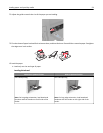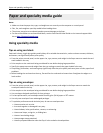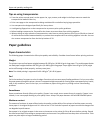
Tips on using transparencies
• From the printer control panel, set the paper size, type, texture, and weight in the Paper menu to match the
transparencies loaded in the tray.
• Print a test page on the transparencies being considered for use before buying large quantities.
• Use transparencies designed specifically for laser printers.
• Avoid getting fingerprints on the transparencies to prevent print quality problems.
• Before loading transparencies, flex and fan the sheets to prevent them from sticking together.
• When printing on large volumes of transparencies, make sure to print by batches of only up to 20 with an interval
of at least three minutes between batches, to prevent the transparencies from sticking together in the bin. You can
also remove transparencies from the bin by batches of 20.
Paper guidelines
Paper characteristics
The following paper characteristics affect print quality and reliability. Consider these factors before printing on them:
Weight
The printer trays can feed paper weights between 60–256 g/m
2
(16–68‑lb) grain long paper. The multipurpose feeder
can feed paper weights between 60–256 g/m
2
(16–68‑lb) grain long paper. Paper lighter than 60 g/m
2
(16 lb) might
not be stiff enough to feed properly, and may cause jams.
Note: Two‑sided printing is supported for 60–169 g/m
2
(16–45‑lb) paper.
Curl
Curl is the tendency for paper to curl at its edges. Excessive curl can cause paper feeding problems. Curl can occur after
the paper passes through the printer, where it is exposed to high temperatures. Storing paper unwrapped in hot, humid,
cold, or dry conditions, even in the trays, can contribute to paper curling prior to printing and can cause feeding
problems.
Smoothness
Paper smoothness directly affects print quality. If paper is too rough, toner cannot fuse to it properly. If paper is too
smooth, it can cause paper feeding or print quality issues. Always use paper between 100 and 200 Sheffield points.
Moisture content
The amount of moisture in paper affects both print quality and the ability of the printer to feed the paper correctly.
Leave paper in its original wrapper until it is time to use it. This limits the exposure of paper to moisture changes that
can degrade its performance.
Store paper in its original wrapper in the same environment as the printer for 24 to 48 hours before printing. Extend
the time several days if the storage or transportation environment is very different from the printer environment. Thick
paper may also require a longer conditioning period.
Paper and specialty media guide 60


















